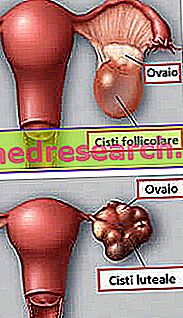Generality
Ovarian cysts are pockets filled with liquid or solid material, which form internally or externally to the ovaries.

In most cases, cysts are small and harmless, while on other occasions they can be large and painful or, even worse, a sign of a malignant ovarian tumor.
To determine the exact nature of an ovarian cyst, and to determine whether it is a benign or malignant tumor, a thorough gynecological examination and a transabdominal or transvaginal ultrasound examination are required.
The less severe ovarian cysts do not provide any treatment, as they heal spontaneously in a few weeks / months. On the other hand, severe ovarian cysts need to be removed surgically to prevent unpleasant consequences.
What is an ovarian cyst?
An ovarian cyst is a sac filled with liquid, or more rarely solid, material present inside or outside an ovary.
WHAT ARE THE OVARIES?
The ovaries (in the singular ovary, but also ovary or ovary ) are the female gonads .
The gonads represent a fundamental part of the human reproductive system, since they are the glands that produce the gametes, or the sex cells.
In number of two and similar in shape to a bean, the ovaries perform two functions:
- They secrete female sex hormones (estrogen and progesterone), which play an essential role in the development of secondary sexual characteristics and reproduction.
- They produce the egg cell (or oocyte or oocyte ), that is the female gamete. This cell is ripened in the first half of the menstrual cycle, after which it is released from the ovary (ovulation) and channeled into the fallopian tubes; in this location, it can possibly be fertilized by a spermatozoon (male gamete).
Each ovary is located on the sides of the uterus .
The uterus is the organ of the female genital apparatus appointed to receive and nourish the fertilized egg cell (ie the embryo first and then the fetus then) throughout the pregnancy.
AN OVARIC CYST IS ALWAYS A PATOLOGICAL SIGN?
In the course of life, a woman's ovary can develop one or more cysts, without these causing any particular symptoms or problems. For this reason, unless they have certain characteristics, ovarian cysts are harmless and resolve spontaneously without the need for special treatments.
Epidemiology
The appearance of ovarian cysts is a very frequent event.
According to Anglo-Saxon statistics, in fact, if at the same time a large number of women could be subjected to an ultrasound examination of the pelvic area, it would appear that almost all subjects of childbearing age, and at least 20% over menopause, have one or more ovarian cysts .
But how many of these women experience cyst-related symptoms or disorders?
According to the same research, only 4 out of 100 women experience problems related to the presence of ovarian cysts over their lifetime.
Causes
Ovarian cysts are mostly physiological and dependent on the menstrual cycle. In a minority of cases, they are instead the effect of a tumor process or other morbid conditions. In light of this, ovarian cysts are divided into two categories:
- Functional cysts . They are the most common version of ovarian cysts. They are due to a physiological process, therefore they are considered completely harmless.
- Pathological (or non-functional) cysts . This category includes cysts that arise due to a tumor, either benign or malignant, and those that are formed during certain diseases, such as endometriosis or polycystic ovary syndrome.
FUNCTIONAL CYCLES
There are 3 types of functional ovarian cysts:

- Luteal cysts (or lutein cysts ). The follicle, after expelling the egg cell, is called the corpus luteum. Sometimes, the opening from which the egg cell is released can close, retaining fluids of various kinds and blood inside. On these occasions, a luteal cyst is formed. The luteal cysts, compared to follicular cysts, are less common but more dangerous: they can, in fact, break suddenly and give rise to painful internal bleeding. Their spontaneous resolution usually takes a few months.
Luteal cysts are particularly frequent during pregnancy.
- Thecal cysts . The tecali cysts are formed starting from the thecal cells that make up the follicle due to the effect of the chorionic gonadotropin, a hormone produced during pregnancy. Both follicular cysts and luteal cysts are less common.
| Size of functional cysts | |
Follicular cysts | On average, they have a diameter of about 2.5 cm |
Luther cysts | On average, they have a diameter of about 3 cm |
PATHOLOGICAL (OR NON-FUNCTIONAL) CYSTS
The main pathological (or non-functional) cysts are:
- Dermoid cysts . Dermoid cysts develop from the cells that produce the oocyte during embryonic life. For this reason, within them it is possible to trace portions of human tissues that resemble hair, bones, fat, teeth or blood. Dermoid cysts can assume important dimensions and reach even 15 centimeters in diameter; when the dermoid cyst is very large and causes an alteration of the normal anatomy of the ovaries and uterus, a surgical intervention may be necessary to remove it. Dermoid cysts are benign tumors that very rarely become malignant.
They are the most common non-functional cysts among women under 40 years.
- Cystadenomas . They are benign tumors that grow on the outer surface of the ovaries and may contain (as cysts) water or mucus. If they contain water, we speak of serous cystadenomas, while if they contain mucus we speak of mucinous cystadenomas.
Serous cystadenomas do not usually reach large dimensions and do not cause particular disorders; mucinous cystadenomas, on the other hand, can grow noticeably and even reach 30 centimeters in diameter.
A large mucinous cystadenoma can push on the adjacent intestine tract or bladder, causing episodes of indigestion or frequent urination; furthermore, it is possible that it will break or obstruct the blood supply to the ovaries.
The conversion of a benign cystadenoma into a malignant tumor is a very rare event.
They are the most common non-functional cysts among women over 40 years.
- Cysts due to endometriosis (or endometriomas) . Endometriosis is a disease characterized by the presence of endometrial tissue outside its natural site, which is the uterus. In some women, however, it can also be distinguished by the appearance of blood-filled ovarian cysts.
- Cysts due to polycystic ovary syndrome . Polycystic ovary syndrome (or polycystic ovary) is a morbid condition characterized by enlarged ovaries and covered by many small cysts. To determine its appearance is usually an imbalance in the production of ovarian hormones (ie produced by the ovaries) and pituitary (ie produced by the pituitary gland).
Symptoms and Complications
In most cases, ovarian cysts do not cause any disturbance; however, when it happens that:
- They reach large sizes and / or
- They break, releasing their content and / or
- They block the direct blood supply to the ovaries (a condition known as ovarian torsion or ovarian torsion )
the following signs and symptoms may appear:
- Pelvic pain . It can be deaf, if the ovarian cyst is large but still intact, or sharp and sudden, if the ovarian cyst is broken. Sometimes, the painful sensation is also felt at the level of the back and thighs.
- Pelvic pain during sexual intercourse.
- Difficulty in completely emptying the intestine.
- Need to urinate often. It is due to the fact that the ovarian cyst constantly presses on the bladder.
- Changes in the normal menstrual cycle.
- Sense of heaviness and swelling in the abdominal area.
- Recurrent indigestion and sense of fullness even after light meals.
- Dizziness, vomiting and a sense of emptiness in the head.
- Sense of persistent fatigue.
WHEN TO REFER TO THE DOCTOR?
If a woman experiences the aforementioned disorders (in particular pelvic pain accompanied by the sense of vomiting), it is advisable to contact your doctor immediately to arrange a check-up. Although dangerous ovarian cysts are infrequent, it is better not to risk and use all the necessary precautions.
COMPLICATIONS
The complications related to the presence of ovarian cysts are due to their rupture (which can give rise to internal bleeding) and to the torsion of the ovaries (because the latter receive little blood).
Diagnosis
Most asymptomatic ovarian cysts (that is, they do not cause symptoms or disorders) go unnoticed (so the patient does not notice it) or is diagnosed by chance, after a pelvic exam or a routine ultrasound.
When cysts are symptomatic, it is always advisable to investigate the nature of the problem and undergo a specialist check-up with a gynecologist .
GYNECOLOGICAL VISIT AND SPECIALIST EXAMINATIONS
During the gynecological examination, the doctor asks the patient to describe the symptoms in progress, investigate their medical history, assess any suspected ultrasound scans and perform a thorough vaginal examination.
If the patient has not yet performed an ultrasound scan, the gynecologist will surely prescribe its execution. In addition, he will prescribe a specific blood test for the CA125 tumor marker.
Ultrasound . It is possible to carry out two types of ultrasound: transabdominal and / or transvaginal. Transabdominal ultrasonography is performed by passing the ultrasound probe onto the patient's abdomen; in this way it shows both the uterus and the ovaries, but it is not always exhaustive.

Figure: appearance of a 2 cm ovarian cyst on ultrasound examination. From the site: en.wikipedia.org
Transvaginal ultrasound, on the other hand, is carried out by introducing the ultrasound probe into the vagina; in this way, it shows in detail the pelvic organs of interest.
Blood tests and specific research of the CA125 tumor marker . Ovarian cysts formed as a result of a malignant tumor process are characterized by the high presence in the blood of a protein called CA125. Therefore, with a specific blood test, the doctor measures the levels of CA125, to make sure of the exact nature of the ovarian cyst found.
However, it must be pointed out that a high level of CA125 is not always due to a malignant ovarian cyst: for example, it can be connected to completely different pathologies, such as endometriosis, pelvic inflammatory disease or tuberculosis.
What features of the ovarian cyst affect the gynecologist doctor? |
The form : is it irregular or not? |
The dimensions : the presence of symptoms is linked to the size of the cysts |
The composition : does the cyst contain liquid or solid material? Or both? The presence of solid matter could mean that the cyst is malignant, therefore it is necessary to carry out further assessment tests. |
Treatment
Asymptomatic ovarian cysts without danger do not require any treatment, as they resolve spontaneously within a few weeks or a few months.
Symptomatic cysts, on the other hand, require much more attention, constant monitoring and, if large or malignant, a surgical treatment.
The parameters that the doctor takes into consideration, to establish the most appropriate cure, are three:
- The size of the cyst
- The severity of the symptoms in place
- The age of the patient, because according to various studies the malignant ovarian cysts are more frequent among women who have passed menopause.
PRINCIPLE OF ACTIVE SURVEILLANCE
Since most of the ovarian cysts are temporary and resolve spontaneously, before considering surgery, doctors advise you to wait a few weeks; during this period of time, the progress of the situation is monitored with regular gynecological examinations and at least two or three ultrasound examinations within a few weeks of each other.
If no improvement is observed, then the possibility of surgical intervention must be examined.
SURGERY: WHEN AND HOW TO INTERVENE?
An ovarian cyst must be removed by surgery if:
- It is of important dimensions
- Causes severe symptoms
- It is malignant or there is a strong suspicion that it is
If the cyst is benign and the patient is still fertile, the operation will only affect the cyst ( ovarian cystectomy ); if, on the other hand, the cyst is very large or perhaps malignant or if the patient is no longer fertile (therefore she has passed the menopause), then the operation will affect the entire sick ovary ( ovariectomy ).
There are two surgical techniques available to the operating doctor:
- Laparoscopy . Reserved for patients with benign cysts of significant size but not excessive, laparoscopy is a minimally invasive surgical procedure, ideal for ovarian cystectomy interventions.

Generally, removal affects the entire ovary, although in cases of benign cancer it is possible to limit the elimination of only the cyst.
Once the operation is completed, the incision is closed with stitches.
The sick ovary (if removed due to a suspected malignant tumor) is delivered to a doctor specialized in pathology, for laboratory tests. The latter (if they confirm the presence of a malignant tumor) allow to establish the degree of tumor malignancy and the chemotherapy therapy to be adopted.
Recovery time for ovarian cystectomy. Intervention in laparoscopy 2 weeks Intervention in laparotomy 6-8 weeks
When do you practice bilateral ovariectomy and hysterectomy?
The presence of a malignant ovarian cyst requires surgeons to remove the healthy ovary ( bilateral ovariectomy ) and the uterus ( hysterectomy ) in addition to the sick ovary. This double intervention is highly invasive and definitively compromises the fertility of a woman not yet in menopause (therefore potentially still able to conceive).
For women of childbearing age who are subjected to the removal of the ovaries and uterus, it is called " surgical menopause ".
Deepening: when to contact the doctor after a surgery?
After a laparoscopy or laparotomy operation, it is quite normal to feel pain in the pelvic area.
It is not normal, however, that:
- The painful feeling gets worse, rather than improving
- Severe blood loss occurs
- The patient has a high fever
- A foul smelling liquid comes out of the vagina of the patient
In the presence of one or more of these symptoms, you should contact your doctor immediately.
WHAT TO DO IN CASE OF STRONG PAIN?
In the case of severe pain in the pelvic area, the doctor advises you to take painkillers, such as paracetamol, and anti - inflammatories, such as NSAIDs (ibuprofen).
In addition, it indicates some soothing remedies, such as applying a bag of warm water on your stomach or taking hot baths.
Prognosis
For most women with ovarian cysts, the prognosis is positive, as the appearance of a cyst is almost always free of unpleasant consequences.
If, however, the cyst has requested the use of surgery, things are decidedly different: we must first consider the reason that led to the operation and, secondly, the type of intervention adopted; in fact, if it is true that ovarian cystectomy and unilateral ovariectomy do not affect the fertility of a woman who is still potentially able to procreate, the same cannot be said for bilateral ovariectomy and hysterectomy.
Prevention
Preventing the appearance of ovarian cysts is impossible.
However, undergoing regular ultrasound scans of the pelvic area and regular gynecological examinations, it is possible to diagnose many abnormalities early that can develop at the level of the female genital tract (therefore not only at the ovaries, but also at the uterus, tube and vagina damages) .
Furthermore, it is good practice to pay attention to any strangeness of the menstrual cycle (irregularities, intense pain, excessive blood loss, etc.) which tends to repeat itself for at least two or three consecutive cycles: this may be, in fact, a sign due to the presence of an ovarian cyst.





